GATNM:药物和类药物分枝杆菌细胞壁渗透性的注意力图神经网络模型
IF 3.8
2区 化学
Q2 AUTOMATION & CONTROL SYSTEMS
Chemometrics and Intelligent Laboratory Systems
Pub Date : 2024-11-21
DOI:10.1016/j.chemolab.2024.105265
引用次数: 0
摘要
结核分枝杆菌的细胞壁具有复杂性和不寻常的组织结构。这些条件使得营养物质和抗生素难以渗透细胞壁,从而影响了多种抗分枝杆菌药物在分枝杆菌细胞中的低活性。基于这些信息,对某些化合物的细胞壁渗透性进行预测就变得非常重要,这将有助于开发新型抗结核药物。最近,利用简化分子输入行输入系统(SMILES)输入药物化合物的计算技术帮助进行了许多预测。在本研究中,我们应用计算技术来预测细胞壁对某些化合物或药物的渗透性。我们评估了几种常见的机器学习模型预测细胞壁渗透性的能力。然而,这些模型都没有达到令人满意的性能。我们研究了一种注意力图神经网络(GATNN)模型来应对这一挑战。就渗透性检测而言,据我们所知,GATNN 模型被认为是提高某些化合物对分枝杆菌细胞壁渗透能力预测性能的一种新方法。此外,我们还通过 Optuna 优化了准确度值,以获得最佳超参数和最佳模型。获得最佳模型后,通过使用基准数据集,该模型的准确率和特异性比之前的模型略有提高,分别达到 78.9% 和 81.5%。作为补充,我们还提供了一个集合模型,并生成了模型的可解释性。本文中所有实验的代码和材料均可从以下链接免费获取:https://github.com/asw1982/MTbPrediction。本文章由计算机程序翻译,如有差异,请以英文原文为准。
GATNM: Graph with Attention Neural Network Model for Mycobacterial Cell Wall Permeability of Drugs and Drug-like Compounds
Mycobacterium tuberculosis cell wall has complexity and unusual organization. These conditions make the nutrients and antibiotics difficult to penetrate this wall which affects the low activity of several antimycobacterial drugs in mycobacteria cells. Based on this information, the cell wall permeability prediction in some compounds becomes important and would help develop novel antitubercular drugs. Recently, there have been many predictions helped by computational technology using the Simplified Molecular Input Line Entry System (SMILES) input drug compounds. In this study, we applied computational technology to predict the permeability of cell walls to some compounds or drugs. We evaluated several common machine learning models for their ability to predict cell wall permeability. However, none of these models achieved satisfactory performance. We investigated a Graph with Attention Neural Network (GATNN) model to address this challenge. In the case of permeability detection, to the best of our knowledge, the GATNN model is considered a new approach to improve the prediction performance of the penetration ability of some compounds to the cell wall of the mycobacterial. Additionally, we optimized the accuracy value to get the best hyperparameter and the best model by Optuna. After getting the optimal model, by using the benchmark dataset, this model has slightly increased the performance over the previous model in accuracy and specificity to 78.9% and 81.5%. As a complementary, we also provided an ensemble model and generated the interpretability of the model. The code and materials of all experiments in this paper can be accessed freely at this link: https://github.com/asw1982/MTbPrediction.
求助全文
通过发布文献求助,成功后即可免费获取论文全文。
去求助
来源期刊
CiteScore
7.50
自引率
7.70%
发文量
169
审稿时长
3.4 months
期刊介绍:
Chemometrics and Intelligent Laboratory Systems publishes original research papers, short communications, reviews, tutorials and Original Software Publications reporting on development of novel statistical, mathematical, or computer techniques in Chemistry and related disciplines.
Chemometrics is the chemical discipline that uses mathematical and statistical methods to design or select optimal procedures and experiments, and to provide maximum chemical information by analysing chemical data.
The journal deals with the following topics:
1) Development of new statistical, mathematical and chemometrical methods for Chemistry and related fields (Environmental Chemistry, Biochemistry, Toxicology, System Biology, -Omics, etc.)
2) Novel applications of chemometrics to all branches of Chemistry and related fields (typical domains of interest are: process data analysis, experimental design, data mining, signal processing, supervised modelling, decision making, robust statistics, mixture analysis, multivariate calibration etc.) Routine applications of established chemometrical techniques will not be considered.
3) Development of new software that provides novel tools or truly advances the use of chemometrical methods.
4) Well characterized data sets to test performance for the new methods and software.
The journal complies with International Committee of Medical Journal Editors'' Uniform requirements for manuscripts.

 求助内容:
求助内容: 应助结果提醒方式:
应助结果提醒方式:


